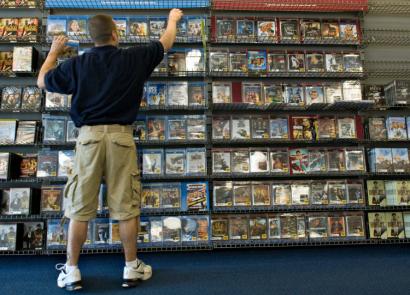
More than 80 percent of households in the United States owned VCRs in the late 1990s, and these households were filled with potential Hollywood Video customers. As a result Hollywood’s target audience was quite broad. The company’s advertising agency indicated that Hollywood’s target market consisted of those aged 18 to 45 as well as suburban families with children. Wattles discussed the company’s consumer target in an interview in the Wall Street Transcript in 1994 and said, ‘‘ . . . when the advertising agencies ask what your demographic profile is, I say, ‘Alive.’’’ Nearly everyone, Wattles elaborated, enjoyed watching movies. ‘‘One thing that’s nice about our business is our demographic profile. It’s so simple. Obviously there are demographic profiles of people who watch more movies than others but the curve is very slight. We’re not just a teenage business, or a midlife business, or an X-generation business.’’ To appeal to this wide audience, Hollywood Video stores focused on the one thing all the customers shared—the love of movies. ‘‘Our store design, our marketing, and our advertising reflect the name and image of Hollywood,’’ he explained. ‘‘We try to create an exciting environment that is movie and/or movie star oriented.’’ Though Hollywood Video’s audience was sizeable, many viewers were growing increasingly distracted by new entertainment technologies and options, such as pay-per-view television programming, digital video disks (DVD), the Internet, and expanded offerings from cable television and direct broadcast satellite. Industry analysts labeled the video-rental market mature, with little growth left. According to a study for the Video Software Rental Association, total revenue from the rental market declined 4.2 percent in 1997. Tom Wolzien, an analyst with Sanford C. Bernstein, pointed to a 1996 poll of 1,000 households with satellite television programming that discovered a 70 percent drop in video rentals. Still, many believed an audience for video rentals remained. Roffman Miller Associates’ Marvin Roffman told the Los Angeles Daily News: ‘‘There were a lot of people on Wall Street that were giving the death knell to the industry . . . [b]ut it’s probably not going to die for a long time. Home video is still a very viable business.’’ Hollywood Video believed this as well, and to continue to attract customers the company implemented many customeroriented policies, such as lower rental prices, guaranteed availability of popular rentals, and five-day rentals on every video in the store. According to the Portland Oregonian, Wattles was not intimidated by new technologies or forecasts of doom; Hollywood Video would, Wattles stated, change with the times and with clientele tastes. ‘‘As long as interest in movies continues, . . . there will be opportunities,’’ Wattles vowed.


